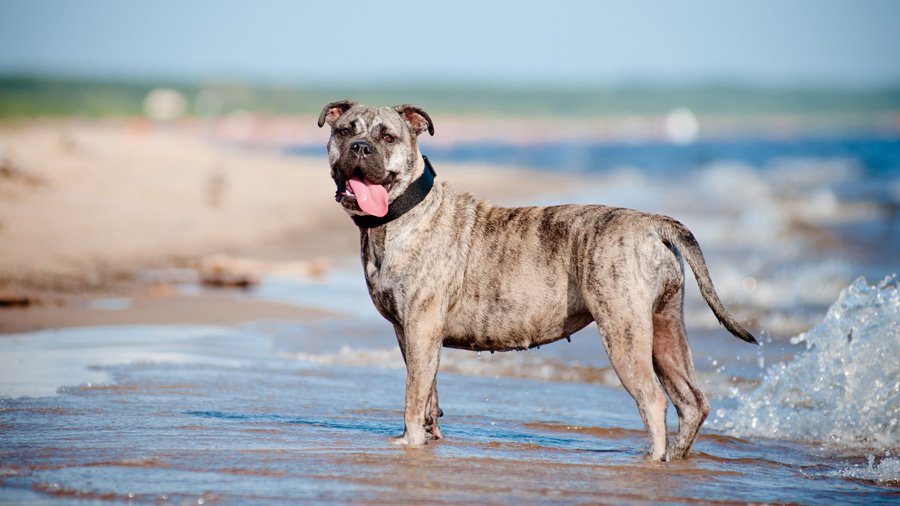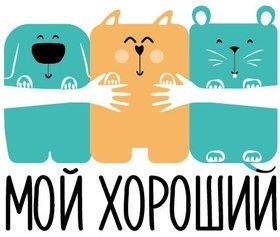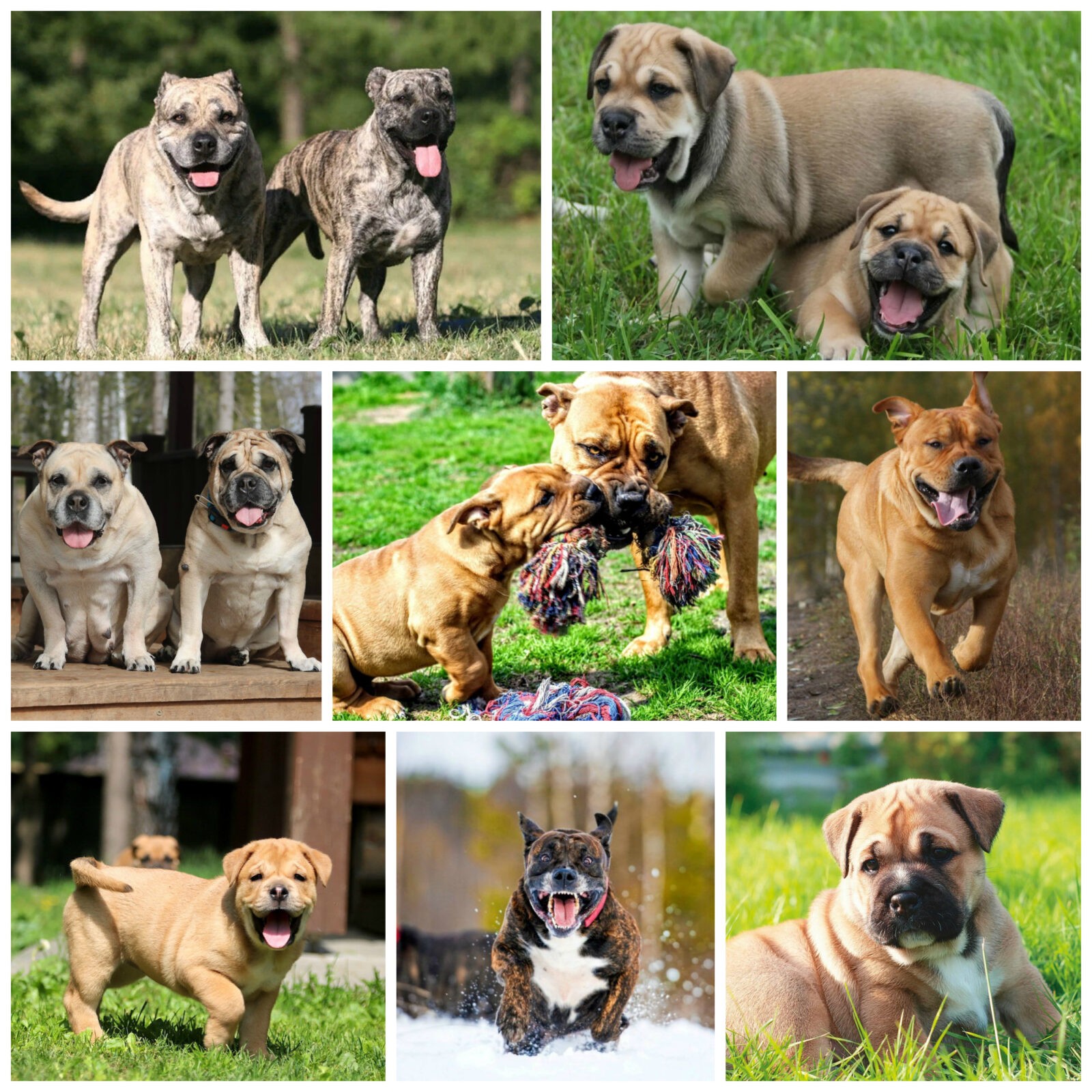Ca de bou are stocky and muscular dogs, beautiful guards, watchman and family members. Related to mastiffs, they are sometimes incorrectly classified as bulldogs, despite the fact that in the veins of these dogs there is blood from both. Other names of the breed - Perogo Mallorquin, Pero de Pressomallorquin, Mallorcan Mastiff (sometimes you can find the name Mallorcan Bulldog) make it possible to find out that the homeland of these animals is Mallorca (Mallorca) - a Spanish island in the Mediterranean Sea.

Brief description of the breed
In ancient times, the breed was used as fighting (in dog fights and battles with bulls) and baiting (during bullfights - national spectacle of the Spaniards). Today, more and more often, the Ca de Bou is kept as a guard dog. Dog owners are like this breeds highlight their main qualities: strength, endurance, courage, kindness and loyalty towards the owner and people close to him, alertness and readiness to engage in battle with the enemy. Ca de bou - dogs whose height is between 58 cm (for males) and 55 cm (for females). The weight of dogs ranges from 30 kg (for females) to 40 kg (for males).
Appearance of the ca de bou
Head: massive, with a large, square-shaped skull. Muzzle: The muzzle is wide and cone-shaped. The forehead is wide, with a pronounced frontal furrow. The transition to the muzzle from the forehead is clearly pronounced. The dog's chewing muscles are clearly visible, with folds of skin above them. The nose is wide and black. The eyes are dark in color, oval in shape, and deep set. The ears are set high and pink (not cropped). Neck: thick, proportional to the large body of the dog. Sometimes with a little suspension. Body: chest cylindrical, deep. The body is muscular, the loin is relatively narrow, with an arch in the croup area. There is a high backside. The stomach is taut. Limbs: muscular (especially the hind legs), straight, widely spaced. The hips and forearms of the ca de bou are wide, with prominent muscles. The paws are strong, oval in shape, with massive toes. Tail: Low set, wide at the base, tapering to the tip (not docked). Coat: short, hard. Color: brindle, black, fawn, red. Possibly a black mask and white markings on the face, front legs and chest.
basic information
| Breed name: | Ca de Bou |
| Country of origin: | Spain |
| The time of the birth of the breed: | 17th century |
| Type of: | Molossians |
| The weight: | 30 – 40 kg |
| Height (height at the withers): | 52 – 58 cm |
| Life Expectancy: | 10 – 12 years old |
|
ICF classification:
|
Group 2, Section 2, Number 249 |
| Puppies price: | 500 – 1500 $ |
| Most popular nicknames: | list of nicknames for Ca de Bou |
Assessment of the characteristics of the Ca de Bou breed
| Adaptability
(a definition meaning how easily a dog can adapt to changes in life) |
🐶🐶 |
| Shedding level
(Level and frequency of hair loss in the animal) |
🐶🐶🐶 |
| Tenderness level
(The level and amount of tenderness and affection that the dog gives in return for attention to itself) |
🐶🐶🐶 |
| Exercise needs
(Dog's daytime activity level) |
🐶🐶🐶 |
| Social need
(The required number of contacts of the dog with other animals, as well as people) |
🐶🐶🐶 |
| Apartment content
(A factor that determines the level of noise and other inconveniences that a dog can deliver to owners in relation to the size of the apartment to the size of the dog) |
🐶 |
| Grooming
(The number of bathing, brushing, and the number of professional grooming sessions required for the dog) |
🐶 |
| Friendliness in an unfamiliar environment
(Features of the behavior of a dog in a society with strangers or in an unfamiliar environment) |
🐶 |
| Tendency to bark
(Tendency to bark and its frequency and volume) |
🐶🐶 |
| Health issues
(Potential health status of the dog) |
🐶🐶🐶🐶 |
| Territoriality
(The dog's tendency to protect his home, yard, or even his owner's car) |
🐶🐶🐶🐶🐶 |
| Friendliness to cats
(The tendency towards tolerance for cats and decreased manifestation of hunting instincts) |
🐶 |
| Intelligence
(The ability of the dog to think and solve emerging difficulties (not to be confused with learning!) |
🐶🐶🐶 |
| Education and training
(The level of difficulty in training the dog to perform certain actions) |
🐶🐶 |
| Friendliness to children
(A factor that determines how friendly a dog is to children, whether he likes to play with them and tolerate some childish pranks) |
🐶🐶 |
| Game activity
(The concept is determined by its very name, and, as a rule, is found in almost all dogs) |
🐶🐶🐶 |
| Observation
(The ability of a dog to detect the presence of a stranger on its territory) |
🐶🐶🐶🐶🐶 |
| Friendliness to other dogs
(The tendency of the dog to find common language with his other relatives) |
🐶 |
Photo of Ca de Bou:
Origin story
Disputes about the origin of these dogs continue. According to one version of ca de bou - descendants of the ancient Alans (an almost extinct breed today) and Pero de Pressa Canario dogs (Dogo Canarios), whose main functions were protecting pastures from predator attacks and protecting the owners’ homes. Introduced to the Balearic Islands in the 12th-13th centuries, these dogs were gradually crossed with local animals, which subsequently made it possible to develop a new breed - ca de bou (“ca de bou” - “bull dog”) to delay a bull before slaughter, for fights with bulls and predators, and for home protection. Today's pero de pressa Mallorquins were undoubtedly crossed with other inhabitants of the Pyrenees - Majorcan Cattle Dogs. Selection work was carried out on crossing with bulldogs.
According to another version, such dogs originated from Iberian mastiffs, known for their high fighting qualities during fights with bulls and their four-legged brothers. Since the 17th century, mastiffs from the Iberian (former name of the Iberian) Peninsula were crossed with fighting and guard dogs, which gave the world a new breed.
Third version of creation - crossbreeding of native Spanish baiting dogs (eg Dogo Cordoba) with Old English bulldogs in the early 17th century. However, this opinion is fundamentally not supported by Spanish dog experts, who emphasize that there is not much bulldog blood in the veins of modern Ca de Bou, although there is a certain similarity in appearance between these dogs. Rather, the direct “relatives” of the Ca de Bou were the mastiffs that inhabited the territories of Spain since ancient times.
Character of Ca de Bou
Maintenance and care
Mallorcan mastiffs live both in apartment conditions (they cannot be called very large) and on the territory of an area fenced with a secure fence in enclosures with an insulated booth. The animal needs its own place where its bowls will stand, toys will lie, and there must be a bed for resting and sleeping.
The coat of these dogs is short, so tangles and stuck dirt do not threaten them. Two or three - Brushing once a week with a special hair removal mitt will help get rid of dead hairs, and during shedding you can use a furminator to gently remove old hairs. Bathing these dogs involves water treatments twice a year using a good shampoo for short-haired dogs. In warm weather, you can give the ca de bou the opportunity to swim in a pond.
The owner should pay attention to the condition of the dog’s eyes, clean the ears twice a week, and trim the nails about twice a month. Particular attention should be paid to the folds on the dog's face after meals and walks, wiping away any accumulations of food or dust to avoid irritation of the dog's skin.
Ca de bou - dogs that need frequent and fairly active walks. Therefore, the owner needs to consider the possibility of walking the dog in special areas every day, for example, by giving the dog the “fetch” command. It’s great if the owner has the opportunity to go out into nature with his pet at any time of the year. - there the dog can run around to his heart's content without a leash and the danger of getting hit by a car, and also will not be involved in a fight. In addition, playing on snowy soil in winter or on a river in summer will increase the load and diversify the dog’s pastime. It will be useful and interesting for young dogs to play sports with their owner, for example, accompany him during a bike ride or ski ride, while swimming and other health-improving procedures.
Training and education
Raising a Ca de Bou must begin with the correct establishment of contact between the dog and its owner. At the same time, a person must certainly take a leading position, not allowing even a small puppy to commit inappropriate pranks (damaging furniture, biting, chasing cats etc.) even for the sake of playing. You should also not communicate with your dog using an overly soft or ingratiating tone. Ca de bou will certainly feel that they can dominate the owner, and then it will be very difficult to properly train dog to existence in society.
So, training with these dogs should begin with adaptation to life in the family and society, and only then can you begin to accustom the baby to a collar and leash. It is worth gently and unobtrusively putting a collar on the dog every day, perhaps turning this ritual into some kind of game, so that later the animal does not have fear and unpleasant sensations associated with the limitation of space and freedom. Ca de bou - dogs very strong, stubborn, but quite obedient and easily grasps the owner’s lessons. At first, a command executed correctly should be appreciated by the owner with a kind word (“well done”, “good”), if the puppy performs everything correctly several times in a row, you can reward him with a treat. At first, you should not punish the puppy by communicating too strictly when the command is not followed, and you should not use physical force. Subsequently, when the dog clearly understands the commands, but for some reason resists following them, you can influence it using your voice and mechanical influence (for example, pressing on the croup area, but not beating).
In addition to learning the basic commands of the Ca de Bou, they often undergo a protective training course, since a dog should not only be guided by its innate abilities when protecting the life of the owner and the territory entrusted to it, the home. A protective training course will greatly increase the dog’s security abilities, will allow you to detain a person who has encroached on the owner or his property, and then release him on command without causing much harm to the criminal. In other words, the dog will combine instinctive skills of protection from a dangerous person under the control of the owner, who will be able to stop the dog if desired.
Health and disease
Some interesting facts
- Ca de boux appeared in Russia relatively recently - in 1994. The first male of this breed was Dumbo del Gore Blau, who won the same 1994 victory at the annual Spanish monobreed exhibition Monographica. Subsequently, this male won many titles, becoming one of the best not only in our country, but throughout the world. The first national exhibition of Ca de Bou in Russia took place in the spring of 1998, it was attended by experienced breeders and presidents of Ca de Bou clubs from Spain. Distinguished guests noted then (and then in the future) the exterior of the Russian Ca de Bou and their compliance with the current Breed Standard. Subsequently, puppies of Russian dogs of this breed were exported to Belarus, Ukraine, Latvia, Lithuania, the Czech Republic, the USA and other countries. Interest in the breed is gradually growing; now these dogs are purchased not only as watchdogs, but also as companions to humans.
- You can buy a Ca de Bou puppy in Russia in many good nurseries, having met not only the dog breeder, but also the puppy’s parents, and learned about hereditary problems or the lack thereof. Often the cost of a puppy can exceed 50,000 rubles, although on the Internet you can find a dog whose cost does not exceed 10,000 rubles. It is up to each owner to choose what is better to save on - on the initial price or expenses for treatment in the future.
Nurseries and breeders
We borrowed material from the wonderful site of our partners DOGCATFAN.COM about cats and dogs, the author dogcatfan

